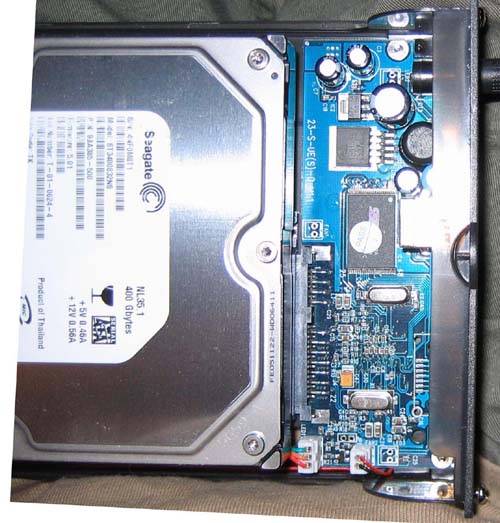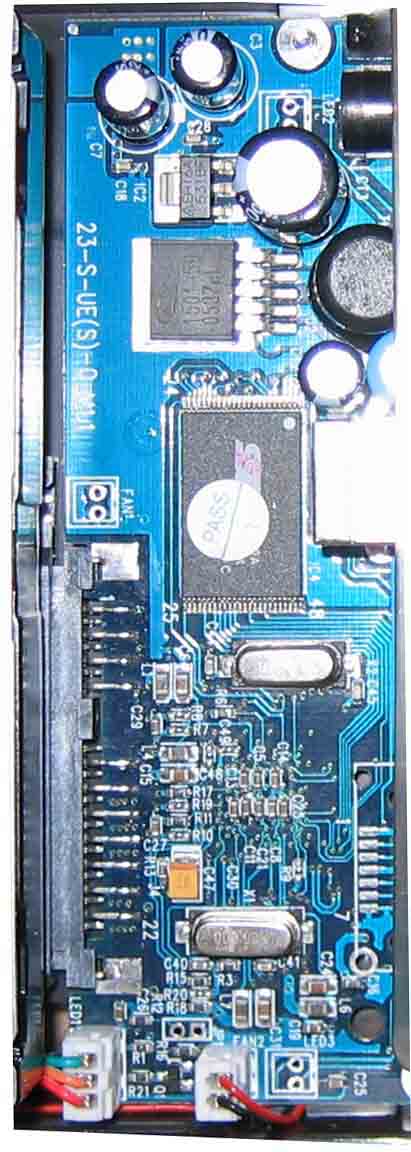External SATA-based Hard Drive (aka "C" drive) with Operating
System

Above: Part of a "home-made" kit
for an external, SATA-based operating system. This image shows an AMS
Venus external hard-drive enclosure (SATA/USB) with Seagate NL-35 400 GB
SATA drive. I'm using this system in a SATA set-up. The USB 2.0 cable (bottom
left of image) is not used. Notice the Venus system also incorporates
an effective cooling fan. This is important as hard drives can run fairly
warm. Many pre-packaged external drives -- such as a Maxtor, Western
Digital, etc. -- do no have internal cooling. One such drive, a hot-running
Maxtor external, failed
after a little over two years in use. It had no internal cooling.
Reliable,
High-Capacity SATA Drives
Seagate provides the ideal solution with the NL35 Series of reliable, high-capacity
enterprise SATA disc drives—stronger and smarter than desktop-class SATA drives,
making them well-suited for capacity-intensive business applications.
- Meets the stringent requirements of 24x7 storage applications
- From 250GB to 500GB storage capacity
- 8 to 16Mbyte cache and native command queuing (NCQ) for enhanced
performance
- Industry-leading five-year warranty

Right: Run the SATA cable (red) from the SATA connector
on the SATA-compliant motherboard thru a "hole" in the back
of the PC. The hole may simply be a removed cover bracket (used for
empty PCI card slots). You'll need your motherboard's "User's Manual" to
help you with the rest of the SATA (software-based) set-up.
I used Acronis True Image to make a mirror (clone) of my old, internal
hard drive (e.g., in Windows, this is "C" drive: the operating
system, Registry, Program Files, My Documents, etc). I did this with
the Venus/Seagate SATA external USB'd to my PC. For me, "C" drive
was originally a dual-drive RAID 0 set-up. Nevertheless, everything mirrored
just fine -- the system started up without a
hitch the very first time I booted "externally".
* True Image takes much of the credit for this; just be sure
to Scan Disk and defragment the original "'C" drive before cloning
.

Right: Here's what my DIY set-up looks like
from the back. The PC tower, continues to house the original dual-hard-drive
RAID 0 set-up I
originally installed upon building this system. I can
also choose to boot from that set-up as well.
Notes:
Power-down and power-up : Notice that with this ad hoc set
up, one must power-up each unit -- the external drive and the PC -- separately.
Like an internal drive, and as long as the PC is on, the Venus drive
will spin-up or spin-down (and eventually, turn off) based on the power
configuration one has set up in the OS (in Windows, right click on the
Desktop, choose Screen Saver > Power ... > Power Schemes). However,
after a PC is shut down, the external HD is still powered. The Venus
drive will
spin-down (and maybe even spin-off) when the PC is powered down. However,
the drive's internal cooling fan continues to operate. I don't like to keep motors
turning indefinitely so I also power down the external drive after powering down
the PC (the switch is inconveniently on the back of the Venus). using
this scheme, one must remember to power up the drive before powering up the PC
(the Venus has a green LED "on" indicator to tell you which state it's
in). My routine with this system is to power it up in the morning, keep it on
while in active use, and then shut down for the day in the early evening. If
I'm going out of the house (which is my office, too), then I'll also shut the
system down. Everything is plugged into a UPS/power conditioner.

Questions regarding "tweakablity":
- Does a "more-linear" DC power supply for PC components
yield improved audio/video?
- Does mechanical damping PC components, chassis and tower hardware
yield better audio/video performance?
Right: Hard-drive
controller board used in the AMS Venus enclosure. The HD (Seagate on left)
easily plugs into it and the enclosure is ready for use in less than five
minutes after unwrapping everything.

Right: A
closer look at the HD-controller board. Is performance-improving tweaking
possible? For starters, the clocks (oval metal "cans" in lower
half of image) may benefit from mechanical damping, as may the rest
of the unit. See this
article for info on data jitter ... and stay tuned
for more details on tweaking this HD based on the same
strategy I've employed on other electronic units ... Right: If you're curious about what this set-up
is used for, check out this
blog entry.

Home | My
PC-based A/V System (circa March 2004) | My
Home A/V System (circa 2001)
This page was last updated:Friday, 2023-11-17 12:32
PST





